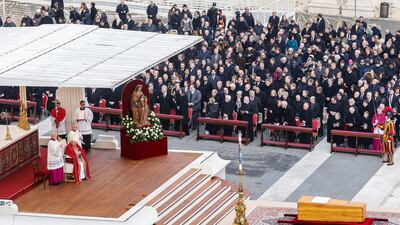The tomb of Pope Benedict XVI has been opened to the public.
The former pontiff, who was the first pope in 600 years to resign, was buried on Thursday after a funeral in St Peter’s Square in Vatican City.
His tomb lies in the grottos under the basilica’s main floor, where the public can now visit after the Vatican opened up access to the site on Sunday.
He died on December 31 at the age of 95, in the Vatican monastery where he spent his final years.
On Thursday, his longtime secretary, Archbishop Georg Gaenswein, imparted a final blessing after Benedict’s body, contained inside three coffins — the cypress one displayed in the square during the funeral presided over by Pope Francis, a zinc one and an outer one hewn from oak — were lowered into a space in the floor.
The remains were placed in the former tomb of Benedict’s predecessor, St John Paul II.
John Paul’s remains were moved up to a chapel on the main floor of the basilica after his 2011 beatification.
About 50,000 people attended Benedict’s funeral, after three days of the body’s lying in state in the basilica, an event which drew nearly 200,000 viewers.
The name of Benedict, the Catholic church’s 265th pontiff, was engraved on a white marble slab, the Vatican said.
The Vatican did not say whether Pope Francis had privately visited the completed tomb of Benedict before public viewing was permitted, or might do so at some other time
On Sunday morning, Francis was leading a ceremony for the baptism of 13 babies in the Sistine Chapel. The chapel, with a fresco by Michelangelo, is the traditional setting for baptisms, an event which closes the Vatican’s year-end ceremonies.
Pope Benedict XVI lies in state - in pictures
Later, greeting pilgrims and tourists gathered in St Peter’s Square for his Sunday noon blessing, Francis quoted from a 2008 homily by Benedict, in which the late pontiff spoke about salvation.
Drawing inspiration from his predecessor’s words, Francis said the faithful when judging others, including in the Catholic church, should apply not harshness but mercy, “sharing the wounds and the fragilities” and avoiding divisions.
Francis has been criticised in some quarters by those who favoured Benedict’s more conservative stance because his funeral homily made only a mere mention of the late pontiff. While Benedict and Francis had spoken of each other with respect, tension festered for years between loyalists of both men.
Benedict shocked the world on February 11, 2013, when he announced in Latin that he was resigning, telling cardinals he was too old and frail to lead an institution with more than 1.3 billion members.
His resignation created the extraordinary situation of having two “men in white” — Francis and Benedict — at the Vatican.
During his time as Pope, he alienated many Catholics with his staunch defence of traditional values and struggled to impose his authority on the church as it battled a string of crises, including over clerical sex abuse.
Benedict repeatedly apologised for the Church's failure to root out sexual abuse of children by members of the clergy and he was the first pope to take serious action against abuse.
Funeral of Pope Emeritus Benedict XVI - in pictures
But last year, an independent report in Germany claimed the pontiff had failed to take action in four abuse cases when he was Archbishop of Munich from 1977 to 1982.
He acknowledged in an emotional personal letter that errors had occurred and asked for forgiveness. His lawyers argued that he was not directly to blame.
Results
2pm: Maiden (PA) Dh 40,000 (Dirt) 1,200m, Winner: AF Thayer, Tadhg O’Shea (jockey), Ernst Oertel (trainer).
2.30pm: Maiden (PA) Dh 40,000 (D) 1,200m, Winner: AF Sahwa, Nathan Crosse, Mohamed Ramadan.
3pm: Handicap (PA) Dh 40,000 (D) 1,000m, Winner: AF Thobor, Szczepan Mazur, Ernst Oertel.
3.30pm: Handicap (PA) Dh 40,000 (D) 2,000m, Winner: AF Mezmar, Szczepan Mazur, Ernst Oertel.
4pm: Sheikh Hamdan bin Rashid Al Maktoum Cup presented by Longines (TB) Dh 200,000 (D) 1,700m, Winner: Galvanize, Nathan Cross, Doug Watson.
4.30pm: Handicap (PA) Dh 40,000 (D) 1,700m, Winner: Ajaj, Bernardo Pinheiro, Mohamed Daggash.
COMPANY%20PROFILE
%3Cp%3E%3Cstrong%3ECompany%20name%3A%3C%2Fstrong%3E%20Co%20Chocolat%3C%2Fp%3E%0A%3Cp%3E%3Cstrong%3EStarted%3A%3C%2Fstrong%3E%202017%3C%2Fp%3E%0A%3Cp%3E%3Cstrong%3EFounders%3A%3C%2Fstrong%3E%20Iman%20and%20Luchie%20Suguitan%3C%2Fp%3E%0A%3Cp%3E%3Cstrong%3EBased%3A%3C%2Fstrong%3E%20Dubai%2C%20UAE%3C%2Fp%3E%0A%3Cp%3E%3Cstrong%3EIndustry%3A%3C%2Fstrong%3E%20Food%3C%2Fp%3E%0A%3Cp%3E%3Cstrong%3EFunding%3A%3C%2Fstrong%3E%20%241%20million-plus%3C%2Fp%3E%0A%3Cp%3E%3Cstrong%3EInvestors%3A%3C%2Fstrong%3E%20Fahad%20bin%20Juma%2C%20self-funding%2C%20family%20and%20friends%3C%2Fp%3E%0A
Water waste
In the UAE’s arid climate, small shrubs, bushes and flower beds usually require about six litres of water per square metre, daily. That increases to 12 litres per square metre a day for small trees, and 300 litres for palm trees.
Horticulturists suggest the best time for watering is before 8am or after 6pm, when water won't be dried up by the sun.
A global report published by the Water Resources Institute in August, ranked the UAE 10th out of 164 nations where water supplies are most stretched.
The Emirates is the world’s third largest per capita water consumer after the US and Canada.
THE SPECS
Engine: 1.5-litre turbocharged four-cylinder
Transmission: Constant Variable (CVT)
Power: 141bhp
Torque: 250Nm
Price: Dh64,500
On sale: Now
The specs: 2018 Kia Picanto
Price: From Dh39,500
Engine: 1.2L inline four-cylinder
Transmission: Four-speed auto
Power: 86hp @ 6,000rpm
Torque: 122Nm @ 4,000rpm
Fuel economy, combined: 6.0L / 100km
The specs
Engine: 2.9-litre twin-turbo V6
Power: 540hp at 6,500rpm
Torque: 600Nm at 2,500rpm
Transmission: Eight-speed auto
Kerb weight: 1580kg
Price: From Dh750k
On sale: via special order
Teri%20Baaton%20Mein%20Aisa%20Uljha%20Jiya
%3Cp%3E%3Cstrong%3EDirectors%3A%3C%2Fstrong%3E%20Amit%20Joshi%20and%20Aradhana%20Sah%3C%2Fp%3E%0A%3Cp%3E%3Cstrong%3ECast%3A%3C%2Fstrong%3E%20Shahid%20Kapoor%2C%20Kriti%20Sanon%2C%20Dharmendra%2C%20Dimple%20Kapadia%2C%20Rakesh%20Bedi%3C%2Fp%3E%0A%3Cp%3E%3Cstrong%3ERating%3A%3C%2Fstrong%3E%204%2F5%3C%2Fp%3E%0A
Dunki
%3Cp%3E%3Cstrong%3EDirector%3A%3C%2Fstrong%3E%20Rajkumar%20Hirani%C2%A0%3C%2Fp%3E%0A%3Cp%3E%3Cstrong%3EStarring%3A%3C%2Fstrong%3E%20Shah%20Rukh%20Khan%2C%20Taapsee%20Pannu%2C%20Vikram%20Kochhar%20and%20Anil%20Grover%3C%2Fp%3E%0A%3Cp%3E%3Cstrong%3ERating%3A%3C%2Fstrong%3E%204%2F5%3C%2Fp%3E%0A
Company%20profile%20
%3Cp%3E%3Cstrong%3EName%3A%20%3C%2Fstrong%3EYodawy%3Cbr%3E%3Cstrong%3EBased%3A%3C%2Fstrong%3E%20Egypt%3Cbr%3E%3Cstrong%3EFounders%3A%20%3C%2Fstrong%3EKarim%20Khashaba%2C%20Sherief%20El-Feky%20and%20Yasser%20AbdelGawad%3Cstrong%3E%3Cbr%3ESector%3A%20%3C%2Fstrong%3EHealthTech%3Cbr%3E%3Cstrong%3ETotal%20funding%3A%20%3C%2Fstrong%3E%2424.5%20million%3Cbr%3E%3Cstrong%3EInvestors%3A%20%3C%2Fstrong%3EAlgebra%20Ventures%2C%20Global%20Ventures%2C%20MEVP%20and%20Delivery%20Hero%20Ventures%2C%20among%20others%3Cstrong%3E%3Cbr%3ENumber%20of%20employees%3A%3C%2Fstrong%3E%20500%3Cbr%3E%3C%2Fp%3E%0A
UAE currency: the story behind the money in your pockets
Engine: 80 kWh four-wheel-drive
Transmission: eight-speed automatic
Power: 402bhp
Torque: 760Nm
Price: From Dh280,000
CREW
%3Cp%3E%3Cstrong%3EDirector%3A%20%3C%2Fstrong%3ERajesh%20A%20Krishnan%3C%2Fp%3E%0A%3Cp%3E%3Cstrong%3EStarring%3A%20%3C%2Fstrong%3ETabu%2C%20Kareena%20Kapoor%20Khan%2C%20Kriti%20Sanon%26nbsp%3B%3C%2Fp%3E%0A%3Cp%3E%3Cstrong%3ERating%3A%3C%2Fstrong%3E%203.5%2F5%3C%2Fp%3E%0A
Red flags
- Promises of high, fixed or 'guaranteed' returns.
- Unregulated structured products or complex investments often used to bypass traditional safeguards.
- Lack of clear information, vague language, no access to audited financials.
- Overseas companies targeting investors in other jurisdictions - this can make legal recovery difficult.
- Hard-selling tactics - creating urgency, offering 'exclusive' deals.
Courtesy: Carol Glynn, founder of Conscious Finance Coaching
WWE Evolution results
- Trish Stratus and Lita beat Alicia Fox and Mickie James in a tag match
- Nia Jax won a battle royal, eliminating Ember Moon last to win
- Toni Storm beat Io Shirai to win the Mae Young Classic
- Natalya, Sasha Banks and Bayley beat The Riott Squad in a six-woman tag match
- Shayna Baszler won the NXT Women’s title by defeating Kairi Sane
- Becky Lynch retained the SmackDown Women’s Championship against Charlotte Flair in a Last Woman Standing match
- Ronda Rousey retained the Raw Women’s title by beating Nikki Bella
GOLF’S RAHMBO
- 5 wins in 22 months as pro
- Three wins in past 10 starts
- 45 pro starts worldwide: 5 wins, 17 top 5s
- Ranked 551th in world on debut, now No 4 (was No 2 earlier this year)
- 5th player in last 30 years to win 3 European Tour and 2 PGA Tour titles before age 24 (Woods, Garcia, McIlroy, Spieth)
MATCH INFO
Uefa Champions League quarter-final, second leg (first-leg score):
Manchester City (0) v Tottenham Hotspur (1), Wednesday, 11pm UAE
Match is on BeIN Sports
GIANT REVIEW
Starring: Amir El-Masry, Pierce Brosnan
Director: Athale
Rating: 4/5
The%20specs%20
%3Cp%3E%3Cstrong%3EEngine%3A%20%3C%2Fstrong%3E2.0-litre%204cyl%20turbo%0D%3Cbr%3E%3Cstrong%3EPower%3A%20%3C%2Fstrong%3E261hp%20at%205%2C500rpm%0D%3Cbr%3E%3Cstrong%3ETorque%3A%20%3C%2Fstrong%3E400Nm%20at%201%2C750-4%2C000rpm%0D%3Cbr%3E%3Cstrong%3ETransmission%3A%20%3C%2Fstrong%3E7-speed%20dual-clutch%20auto%0D%3Cbr%3E%3Cstrong%3EFuel%20consumption%3A%20%3C%2Fstrong%3E10.5L%2F100km%0D%3Cbr%3E%3Cstrong%3EOn%20sale%3A%20%3C%2Fstrong%3ENow%0D%3Cbr%3E%3Cstrong%3EPrice%3A%20%3C%2Fstrong%3EFrom%20Dh129%2C999%20(VX%20Luxury)%3B%20from%20Dh149%2C999%20(VX%20Black%20Gold)%3C%2Fp%3E%0A
AIDA%20RETURNS
%3Cp%3E%3Cstrong%3EDirector%3A%20%3C%2Fstrong%3ECarol%20Mansour%3C%2Fp%3E%0A%3Cp%3E%3Cstrong%3EStarring%3A%20%3C%2Fstrong%3EAida%20Abboud%2C%20Carol%20Mansour%3C%2Fp%3E%0A%3Cp%3E%3Cstrong%3ERating%3A%3C%2Fstrong%3E%203.5.%2F5%3C%2Fp%3E%0A
At Eternity’s Gate
Director: Julian Schnabel
Starring: Willem Dafoe, Oscar Isaacs, Mads Mikkelsen
Three stars
What is a black hole?
1. Black holes are objects whose gravity is so strong not even light can escape their pull
2. They can be created when massive stars collapse under their own weight
3. Large black holes can also be formed when smaller ones collide and merge
4. The biggest black holes lurk at the centre of many galaxies, including our own
5. Astronomers believe that when the universe was very young, black holes affected how galaxies formed
The%20specs
%3Cp%3E%3Cstrong%3EEngine%3A%20%3C%2Fstrong%3E3.0%20twin-turbo%20inline%20six-cylinder%0D%3Cbr%3E%3Cstrong%3ETransmission%3A%20%3C%2Fstrong%3Eeight-speed%0D%3Cbr%3E%3Cstrong%3EPower%3A%20%3C%2Fstrong%3E503hp%0D%3Cbr%3E%3Cstrong%3ETorque%3A%20%3C%2Fstrong%3E600Nm%0D%3Cbr%3E%3Cstrong%3EPrice%3A%20%3C%2Fstrong%3Efrom%20Dh400%2C000%20(estimate)%0D%3Cbr%3E%3Cstrong%3EOn%20sale%3A%20%3C%2Fstrong%3Enow%3C%2Fp%3E%0A
COMPANY PROFILE
Name: Kumulus Water
Started: 2021
Founders: Iheb Triki and Mohamed Ali Abid
Based: Tunisia
Sector: Water technology
Number of staff: 22
Investment raised: $4 million
GROUPS
Group Gustavo Kuerten
Novak Djokovic (x1)
Alexander Zverev (x3)
Marin Cilic (x5)
John Isner (x8)
Group Lleyton Hewitt
Roger Federer (x2)
Kevin Anderson (x4)
Dominic Thiem (x6)
Kei Nishikori (x7)
Mohammed bin Zayed Majlis
Huddersfield Town permanent signings:
- Steve Mounie (striker): signed from Montpellier for £11 million
- Tom Ince (winger): signed from Derby County for £7.7m
- Aaron Mooy (midfielder): signed from Manchester City for £7.7m
- Laurent Depoitre (striker): signed from Porto for £3.4m
- Scott Malone (defender): signed from Fulham for £3.3m
- Zanka (defender): signed from Copenhagen for £2.3m
- Elias Kachunga (winger): signed for Ingolstadt for £1.1m
- Danny WIlliams (midfielder): signed from Reading on a free transfer
HAJJAN
%3Cp%3EDirector%3A%20Abu%20Bakr%20Shawky%C2%A0%3C%2Fp%3E%0A%3Cp%3E%3Cbr%3EStarring%3A%20Omar%20Alatawi%2C%20Tulin%20Essam%2C%20Ibrahim%20Al-Hasawi%C2%A0%3C%2Fp%3E%0A%3Cp%3E%3Cbr%3ERating%3A%204%2F5%3C%2Fp%3E%0A

























